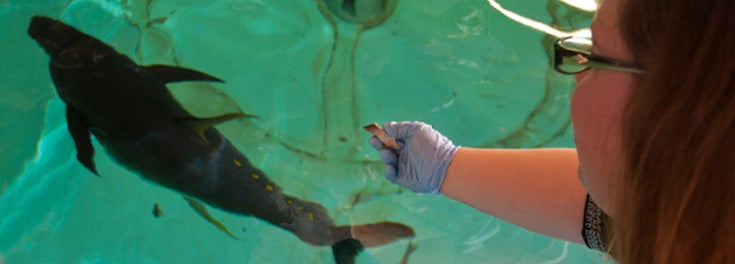
So you like to eat tuna? Or maybe you don’t. But a lot of people do, and the growing demand worldwide has led to so many bluefin tuna “ranching” operations around the world that the species has become endangered. URI Professor Terry Bradley and his graduate and undergraduate students are working on a solution: “We’re trying to breed and produce fish in captivity and take the pressure off the wild stock,” said grad student Taylor Voorhees.
If they’re successful, Professor Bradley and his students would become the first in the United States to successfully breed tuna from birth.
Unlike what’s happening in other places around the world, where tuna after tuna are captured from the wild, put into pens and raised to harvest size, Professor Bradley’s team wants to breed tuna from eggs, beginning with just a few wild-caught tuna and a 20,000 gallon tank at URI’s Narragansett Bay campus. They are beginning their work with the smaller, more plentiful, and less demanding (as far as breeding goes) yellowfin tuna, and hope to gradually incorporate bluefin tuna and a much larger tank. If they are successful, Professor Bradley and his students would become the first in the United States to successfully breed tuna from birth.
But it won’t be easy, for a number of reasons. Tuna are long-distance migrants that swim at great speeds and need a lot of space, and acclimating them to a 20-foot diameter tank has been difficult. The sex of yellowfin tuna can’t be determined, so the researchers have to catch enough wild fish to make spawning probable. But too many fish in even a 20,000 gallon tank jeopardizes water quality and makes spawning less likely. And finally, once the fish do spawn and the eggs hatch, the microscopic larvae first must be fed live food raised on site and then weaned to a dry, formulated feed.
They are working in partnership with Rhode Island-based Greenfins Inc. to develop the techniques for successfully raising tuna from egg to harvest size, and hope to create a new sustainable industry in Rhode Island in the process. “These early stages of the project are all about research – learning about the early life cycle of these fish and developing the techniques to raise them. But we also think there is a lot of commercial potential,” said Professor Bradley. He and Greenfins President Peter Mottur ’91 envision local entrepreneurs using the techniques they develop to produce juvenile tuna that could then be sold to others who want to grow them further, while minimizing any negative impact on the wild population. In Japan, an eight-inch juvenile tuna raised in captivity can be sold for $100 to $125.
“It’s a sustainable project that we hope will create green technology jobs here in Rhode Island. We’ve already developed a partnership between URI and my company, and we hope to take it from the research phase to the commercialization phase once we demonstrate tuna breeding and larval rearing success,” Mottur said. Professor Bradley said that right now, Japan can’t produce all the tuna it needs for the country’s own purposes, and the U.S. is a big importer of tuna. “There’s a tremendous potential for us to produce fish that could easily be sold in the U.S., especially if it’s a sustainable product produced in an environmentally responsible manner.”
Pictured: Graduate students Chelsea Roy and Taylor Voorhees feed the yellowfin tuna and false albacore currently residing in the 20,000-gallon tank.
